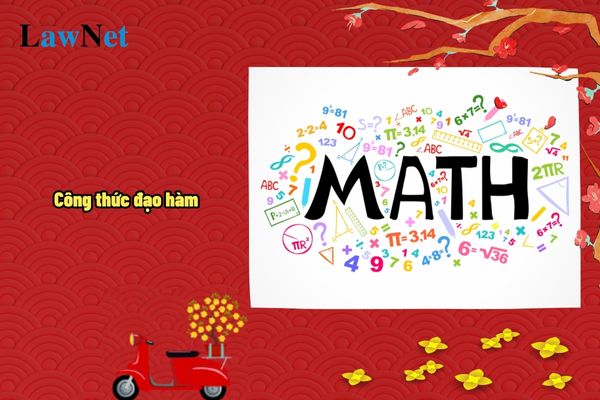What is the derivative formula? What are the specific examples of the derivative formula under the 11th-grade Mathematics curriculum in Vietnam? Under the new program, what are the required outcomes regarding derivatives for 11th-grade students in Vietnam?
What is the derivative formula? What are the specific examples of the derivative formula under the 11th-grade Mathematics curriculum in Vietnam?
11th-grade students may refer to the following information on the derivative formula and specific examples of the derivative formula under the 11th-grade Mathematics curriculum:
|
What is the derivative formula? What are the specific examples of the derivative formula under the 11th-grade Mathematics curriculum in Vietnam? The derivative is an important concept in mathematics, especially in Calculus. It represents the rate of change of a function at a specific point on the graph of that function. In other words, the derivative indicates whether the function is increasing, decreasing, or constant at a certain point. |
*Note: Information is for reference only./.

What is the derivative formula? What are the specific examples of the derivative formula under the 11th-grade Mathematics curriculum in Vietnam? Under the new program, what are the required outcomes regarding derivatives for 11th-grade students in Vietnam? (Image from Internet)
Under the new program, what are the required outcomes regarding derivatives for 11th-grade students in Vietnam?
Under subsection 3, Section 5 of the General Education Program in Mathematics issued under Circular 32/2018/TT-BG/DDT, the required outcomes regarding derivatives for 11th-grade students in Vietnam include:
| Content | Required outcomes |
| Concept of derivative. Geometric meaning of the derivative | - Recognize some problems leading to the concept of a derivative such as: determining the instantaneous velocity of an unevenly moving object, determining the rate of temperature change. - Recognize the definition of a derivative. Be able to calculate the derivative of some simple functions by definition. - Recognize the geometric meaning of the derivative. - Establish the equation of the tangent line of the function graph at a point on the graph. - Recognize the number e through problems modeling bank interest rates. |
| Rules for calculating derivatives | - Be able to calculate the derivative of some basic elementary functions (such as polynomial functions, simple radical functions, trigonometric functions, exponential functions, logarithmic functions). - Be able to use formulas for calculating the derivative of the sum, difference, product, quotient of functions and derivative of composite functions. - Solve some problems related to other subjects or practical issues associated with derivatives (e.g., determining the instantaneous velocity of an unevenly moving object,...). |
| Second derivative | - Recognize the concept of the second derivative of a function. - Be able to calculate the second derivative of some simple functions. - Solve some problems related to other subjects or practical issues associated with the second derivative (e.g., determining acceleration from the velocity-time graph of an uneven motion,...). |
What are the objectives of the 11th-grade Mathematics curriculum in Vietnam regarding basic mathematical knowledge and skills?
Under the General Education Program in Mathematics issued under Circular 32/2018/TT-BGDĐT, specific regulations are as follows:
Mathematics at the lower secondary level aims to help students achieve the following main objectives:
+ Contribute to the formation and development of mathematical competence with the requirement to: pose and answer questions during reasoning, solve problems, perform reasonable reasoning when solving problems, and prove not-too-complex mathematical propositions;
+ Be able to use mathematical models (mathematical formulas, algebraic equations, representations,...) to describe situations in some uncomplicated real-life problems; use mathematical language combined with ordinary language to express mathematical content as well as demonstrate evidence, reasoning, and results; present ideas and how to use tools and means for learning mathematics to perform a learning task or to describe arguments or proofs in mathematics.
+ Have basic mathematical knowledge and skills about:
++ Numbers and Algebra: The number system (from natural numbers to real numbers); calculation and use of calculation tools; algebraic language and symbols; transform algebraic expressions, equations, systems of equations, inequalities; use function language to describe (model) some processes and phenomena in reality.
++ Geometry and Measurement: Geometry and Measurement content at this education level include Visual Geometry and Plane Geometry.
Visual Geometry continues to provide language, symbols, and descriptions (at a visual level) of real-world objects (plane shapes, solid shapes); establish some common geometric models; calculate some geometric elements; develop spatial imagination; solve some simple practical problems related to Geometry and Measurement.
Plane Geometry provides knowledge and skills (at a reasoned logic level) about geometric relationships and some common plane figures (points, lines, rays, line segments, angles, two parallel lines, triangles, quadrilaterals, and circles).
++ Statistics and Probability: Collect, classify, represent, analyze, and process statistical data; analyze statistical data through frequency, and relative frequency; recognize some simple statistical laws in practice; use statistics to understand the basic concepts of the experimental probability of an event and the probability of an event; recognize the meaning of probability in practice.
+ Help students have an initial understanding of careers related to mathematics; have a sense of career orientation based on abilities, interests, conditions, and personal circumstances; and orient streamlining after lower secondary education (continue studying, vocational training, or engage in working life).

